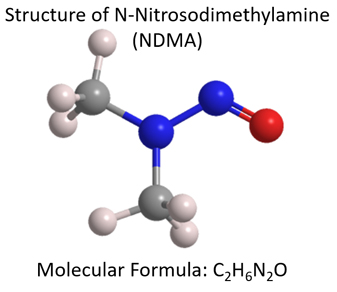Free Case Evaluation
You will never be charged a fee unless a recovery is made for you.

NDMA (N-nitrosodimethylamine) is a dangerous cancer-causing chemical that has recently been detected in some medicines. Water and many foods may contain low levels of NDMA but those levels are typically not high enough to cause harm. But recently the Food and Drug Administration (FDA) has found NDMA in higher-than-recommended levels in some medicines. Some lots of medicines, such as Zantac® (ranitidine), an antacid, have been recalled. Some medicines, such as valsartan, a medicine used to treat high blood pressure and, in some cases, heart failure, and metformin, a drug for type-2 diabetes, are being subjected to further testing.
There are patients who have contracted certain types of cancer after taking Zantac or other ranitidine drugs or valsartan who are filing Zantac lawsuits and valsartan lawsuits.

NDMA is an organic chemical. It is a yellow liquid and has no particular odor. It is not currently produced in the United States or used commercially in the U.S. except for research. NDMA used to be used in the production of liquid rocket fuels but that practice ended when high levels of NDMA were then found in air, water, and soil samples taken from areas near a rocket fuel manufacturing facility.
In spite of not being intentionally produced in the U.S., except for research purposes, NDMA is created as a by-product of various manufacturing and natural processes via chemical reactions.
For example, processes that involve alkylamines, which are naturally occurring and man-made compounds found in the environment, may produce NDMA via chemical reaction. Industrial sources that involve alkylamines include:
NDMA is also an unintended by-product of chlorination of drinking water and wastewater at treatment plants that use chloramines for disinfection.
People may be exposed to NDMA through a wide variety of sources—environmental, consumer, and occupational. Again, water and many foods contain some amount of NDMA, but those levels are typically not high enough to cause harm.
NDMA exposure can occur by, among other things:
Examples of where occupational (work) exposure may occur include:
Recently NDMA has been found in higher-than-recommended levels in some medicines, including Zantac and Valsartan. Why now, after those drugs have been on the market for quite a few years?
The most plausible theory is that manufacturing processes have changed. As noted, for example, processes that involve alkylamines may produce NDMA via chemical reaction. It is possible that drugs being investigated now contain too-high levels of NDMA due to just such a chemical reaction during the manufacturing process.
Organs that may potentially be affected by NDMA include:
NDMA is especially harmful to the liver.
Possible symptoms of overexposure to NDMA include:
High levels of exposure can also cause reduced function of the lungs and kidneys as well as severe liver damage and internal bleeding.
The Environmental Protection Agency (EPA) has classified NDMA as a probable human carcinogen. The U.S. Department of Health and Human Services (DHHS) says that NDMA is reasonably anticipated to be a human carcinogen. And the International Agency for Research on Cancer (IARC) has classified NDMA as probably carcinogenic to humans.
Dr. William Mitch, a professor of civil and environmental engineering and wastewater expert at Stanford University, told ABC News that NDMA acts as a carcinogen “because it modifies your DNA.”
Long-term exposure to NDMA has been linked to many types of cancer. Trustwell is accepting Zantac cases involving these five cancer types:
Sources
You will never be charged a fee unless a recovery is made for you.